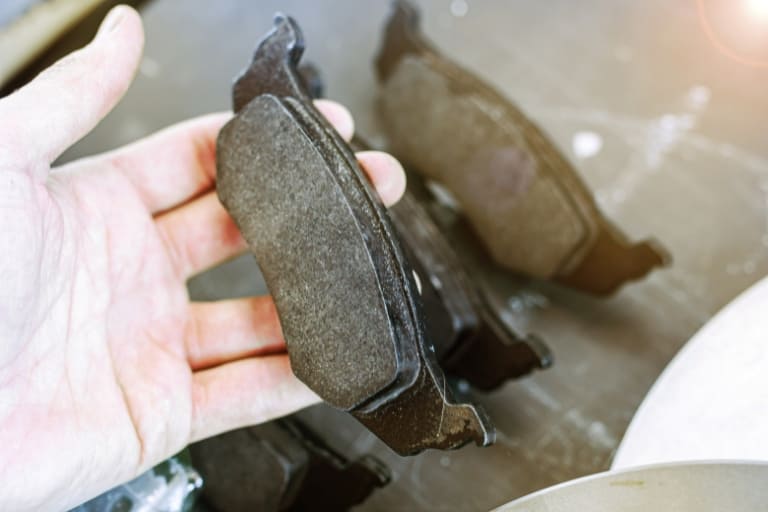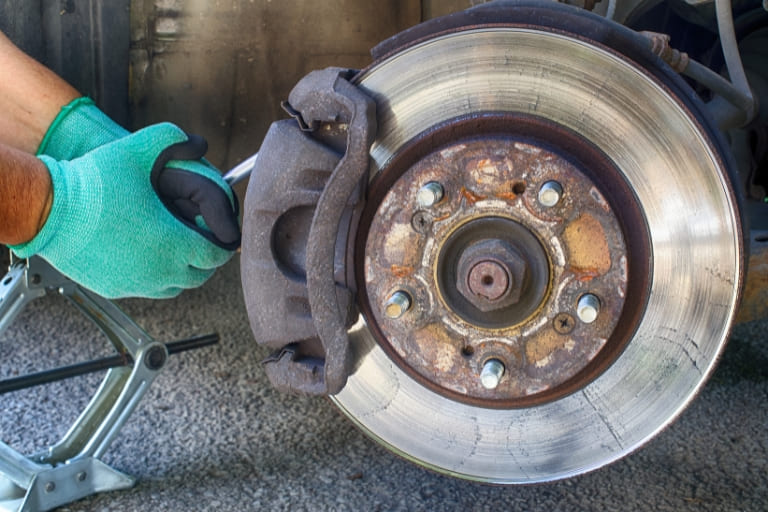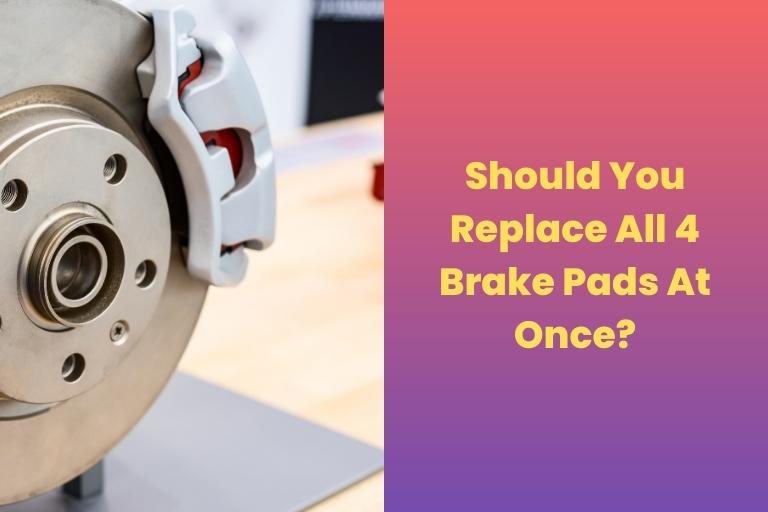Many car owners are faced with deciding whether to replace all 4 brake pads at once. Maintaining a vehicle’s braking system is crucial for road safety, but the best approach to changing brake pads is frequently unknown. Some drivers dispute whether replacing all four brake pads at once is necessary, while others believe that merely replacing the worn-out pads is sufficient.
In this article, we will look at the benefits and drawbacks of both approaches, offering information to assist you in deciding on brake maintenance. Keep reading if you’re a car owner who wishes to keep your vehicle’s braking system in excellent operating order.
Without further ado, let’s get straight into the content!
Contents
- 1 Is it necessary to replace all 4 brake pads at the same time?
- 2 The Advantages and Disadvantages of Replacing All the four brake pads
- 3 The Advantages and Disadvantages of Replacing Only Worn Brake Pads
- 4 What Is the Cost of Replacing All Four Brake Pads at Once?
- 5 Frequently Asked Questions
- 6 Conclusion
Is it necessary to replace all 4 brake pads at the same time?
To answer this question, it is not always mandatory to replace all four brake pads simultaneously. Nevertheless, replacing the brake pads on either the front or rear wheels in pairs is crucial, as the front pads tend to wear out faster due to their heavier workload. It’s worth noting that some automakers may recommend replacing all four sets of brake pads simultaneously, with one set for each wheel. To determine whether all four wheels necessitate new brake pads, it’s essential to have your brakes inspected regularly by a professional mechanic.
The primary reason for this is to achieve even wear and to improve braking performance. Replacing only the worn-out pads might result in uneven wear, lowering braking efficiency and perhaps resulting in more expensive repairs in the long term.
Furthermore, replacing all four brake pads at once allows for a more thorough inspection of the braking system, which can aid in identifying any other issues that may require attention.
The choice to replace all four brake pads at once ultimately depends on the condition of the brake pads and the advice of your mechanic or vehicle manufacturer.
The Advantages and Disadvantages of Replacing All the four brake pads

Replacing all four brake pads simultaneously is an excellent choice for some drivers, but it is only sometimes essential. This strategy has advantages and disadvantages, which must be carefully considered before deciding.
Advantages
Improved braking performance:
Since all four brake pads have the same amount of friction material, replacing all four pads at the same time can result in more balanced braking performance.
Cost efficiency:
Replacing all four brake pads at the same time can be more cost effective in the long run, as you can save on labor costs by having everything done at once rather than in separate steps.
Convenience:
Replacing all four brake pads at once means you only need to arrange one appointment and can complete the repair in one visit rather than making repeated journeys to the technician.
Disadvantages
Unnecessary expense:
If just one or two brake pads must be replaced, replacing all four might be unnecessary. Replacing only the worn pads rather than all four may be more cost-effective in some circumstances.
The Advantages and Disadvantages of Replacing Only Worn Brake Pads
Another alternative for drivers who need to fix their brakes is to replace the worn brake pad. Like changing all four brake pads, this method has advantages and disadvantages.
Advantages
Cost-effectiveness:
Replacing only the worn brake pad saves money over replacing all four since you only pay for the service and components you need.
More focused repair:
If only one brake pad is worn, replacing it can address the problem more effectively, while replacing all four pads may be an unnecessary expense.
Disadvantages
Imbalanced braking:
Replacing merely one brake pad might result in an imbalance in braking performance since the new pad has a different quantity of friction material than the other pads. This can result in decreased braking efficiency and potentially hazardous braking circumstances.
Need for frequent inspections:
Frequent checks are required if only one brake pad is replaced. This ensures that the other pads are worn equally and that any new concerns are addressed as they develop.
What Is the Cost of Replacing All Four Brake Pads at Once?

The cost of changing all four brake pads varies according to the vehicle’s make and model, the kind of brake pads used, and the repair shop’s location. The average cost of parts per axle ranges from $35 to $150, while the average labor cost per axle ranges from $80 to $120. Typical brake pad replacement costs range from $115 to $300 per axle or $200 to $800 for all four wheels.
The cost of the brake pads themselves, any additional components or labor needed, and the store’s hourly rate are all factors to consider when calculating the cost of brake replacement.
The type of brake system, the condition of the brake rotors, and the complexity of the repair are all factors that affect the cost of a brake repair. In other circumstances, extra work, such as replacing brake lines or calipers, may be required, increasing the entire cost.
To save money on a brake job, look around for the cheapest price and consider using aftermarket brake pads rather than OEM components. Furthermore, performing regular brake maintenance and detecting potential problems early can help prevent more costly repairs in the future.
Frequently Asked Questions
Can you just change 2 brake pads?
Yes. It is possible to change only 2 brake pads, but replacing all 4 at the same time is generally recommended. Replacing only 2 pads can cause uneven wear and reduce the effectiveness of the brakes. Additionally, if the other 2 pads are already worn down significantly, they may need to be replaced soon. Replacing all 4 pads at once ensures even wear and can maximize braking performance.
Should Front and Rear Brake Pads be replaced simultaneously?
Replacing the front and rear brake pads at the same time is not always necessary, but it is frequently recommended. This is due to the fact that the brake pads on each axle wear down at the same pace, so if one set of pads has to be replaced, the other set may be close behind. Replacing all the pads guarantees even wear and can enhance brake efficacy.
How long does replacing all the brake pads take?
The time it takes to replace all of the brake pads depends on various factors, including the vehicle’s brand and model, the braking system’s state, and the mechanic’s experience. Replacing brake pads can take anywhere from 30 minutes to an hour per axle. The repair time may be extended if further work is required, such as replacing the rotors or calipers.
Can you replace just one set of brake pads?
Yes. You can replace only one set of brake pads, either front or rear. However, replacing all four pads at the same time is generally recommended to ensure even wear and maximize braking performance. If you merely change one set of brake pads, the second set will wear unevenly, reducing the efficacy of the brakes.
Related Article:
- How Close Should Brake Pads Be To Rotors?
- Can You Spray Brake Cleaner On Brake Pads? Does It Help?
- Can You Put Brake Pads On Backward? Why Should You Avoid?
- Brake Shudder After New Rotors And Pads? Here Is The Fix
- Are Brake Pads Interchangeable? Let’s Find Out
- Does The Emergency Brake Lock All Wheels?
- How Long Can You Drive On Grinding Brakes?
- Do Ceramic Brake Pads Contain Asbestos?
- Can You Use Front Brake Pads On The Rear?
- Why Does My Car Shake After Changing the Brake Pads?
- Why Wheel Won’t Spin After A Brake Change? Apply These Fixes
- Why Are Brake Pads Not Touching The Whole Disc?
- How Long Do Brake Pads Last: Brake Pad Lifespan Explained
- How to Install Anti-Rattle Clips on Brake Pads
- Driving Without Brake Pads: How Long is Safe?
- Fixing New Ceramic Brake Pads Making a Grinding Noise
- Ceramic vs. Semi-Metallic Brake Pads: Which is Better?
- Why Are My Brakes Grinding After New Pads And Rotors
- Ceramic vs OEM brake pads
- Ceramic vs Organic Brake Pads: In-depth Comparison
- Ceramic vs Carbon Fiber Brake Pads: A Comprehensive Comparison
Conclusion
To summarize, while it is feasible to replace only one set of brake pads, it is advised that all four pads be replaced at the same time. This promotes even wear and enhances braking effectiveness, allowing for a complete brake system check.
The cost of replacing all four brake pads might vary based on various circumstances. Still, car owners can save money by looking around for the best deal and contemplating purchasing aftermarket brake pads rather than OEM components.
Furthermore, performing regular brake maintenance and detecting potential problems early can help prevent more costly repairs in the future.
Finally, the choice to change brake pads should be based on the condition of the brake pads and the advice of a trustworthy mechanic or vehicle manufacturer. Car owners may guarantee that their vehicle’s braking system is in top shape and ready to keep them safe by prioritizing brake safety and maintenance.
